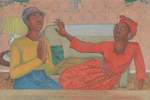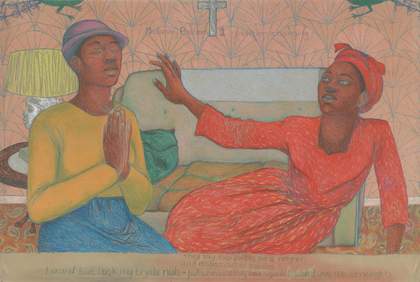You will need:
- Large sheets of paper – you could use lining paper
- Wax crayons or oil pastels
- Watercolour paints
- Chalk
- Images of fabrics and patterns from magazines


You will need:

Sonia Boyce OBE
Missionary Position II (1985)
Tate
Your students don’t need to know anything about an artwork or artist to start exploring it.
Use these quick group activities to build their confidence and curiosity in sharing their first responses to the artwork. Some artworks they might like straight away, some they might not.
Discovering art can be new, exciting and sometimes confusing. There are no right or wrong ways to respond!
In pairs or as a group, take it in turns to imagine the artworks answering these questions and telling their story.
In pairs or as a group, use your body to respond to the artwork.
Missionary Position II 1985, is a large drawing made with watercolour, pastel and crayon on paper by the artist and educator Sonia Boyce. It draws inspiration from the intersection of different cultures. Boyce uses herself as the model for both figures, with the differences between them suggesting her growing antipathy towards her Christian upbringing. On the wall behind the two figures are the words: ‘Missionary Position II position changing’, which brings in a questioning voice. The praying figure implies passive acceptance while the figure on the right, through pose and dress, proposes an alternative stance.
The figure on the right wears a head-wrap, reflecting a growing sense of cultural freedom and connectedness across the African diaspora. By contrast, the ‘missionary position’ title stands as a metaphor for the role of Christian missionaries in supporting colonial rule and oppression in Africa and the Caribbean. By exploring these differences, Boyce surfaces questions around the tensions or contrasting positions of different aspects of her experience.
Sonia Boyce’s work involves a variety of media, including drawing, print, photography, video, collaboration and sound. She is a British Afro-Caribbean artist who was born in Islington, London to Caribbean parents; her mother from Barbados, her father from Guyana. She belongs to a generation of Black artists who emerged in the early 1980s and aimed to establish a visibly Black art that addressed social and political issues relevant to their communities.
Sonia Boyce used herself as the model for both figures in this drawing. In this activity, explore how to start from your own body when making art.
Adapt
Use role play to create individual or group poses that correspond to particular activities – mealtime, playtime etc.
Use a projector or other light source to create shadows of the poses against a sheet of paper, then make large drawings by drawing around the shadow.
Finally, use different materials techniques – paint, handprints, collage – to fill in each shape with a different pattern or texture.
4. On a sheet of paper using a wax crayon/oil pastel, draw round your arm and hand positioned in its first pose and then draw round your second arm pose. If this is difficult you could get your partner to help you. You should now have two contrasting arm/hand outlines next to each other on your sheet of paper.
5. Patterns play a big part in Boyce’s drawing. Think about where pattern shows up in your life, on your clothes, wallpaper at home, your duvet cover. Pattern can be purely decorative or can add a further layer of meaning by referencing specific things. Think of a pattern that you know well (or can see in the classroom) and use it to fill up the background to your poses. Be bold and go big!
6. In the drawing by Sonia Boyce, the two figures have very different coloured clothes. One is blue and yellow and one is entirely dressed in red. Add colour to your pattern.
What colours do you want to use? Why?
Does the background change what the arms feel like?
7. Now you have a choice about how you complete the pose drawings.
Option 1
Repeat the pattern activity, selecting and adding a different bold pattern onto each of your poses and thinking about what this mash-up of pattern and pose communicates.
Option 2
Look again at how Boyce uses colour to bring her figures to life before having a go at achieving something similar yourself.
8. At the end of your lesson, bring all of your pieces to the front of your classroom and look at them together. Find how these two options impact the experience of looking at the artworks. Return to the idea of how different poses or gestures can hold and communicate different – sometimes opposing – positions, attitudes or ideas.
What do your artworks say back to you?
Extend
Invite your students to work over a number of sessions to experiment with colour and surface. Try using washes of colour over the wax/oil pastel drawings. How does the crayon resist the paint and what effect does this have?
Gather as a group into one collective pose and use the light of a projector or lamp to cast your group shadow onto a large piece of paper on the wall. One or two of you can draw the outline of the shadow and then you can work collaboratively on your image as a group.
Spend more time thinking about pattern, how this is created – e.g. through repetition, tessellation, colour – and how it can communicate – by incorporating particular motifs, cultural or historic references, even text! Ask your students to research and design patterns with a view to communicating a specific message.
Making art is a powerful way to learn new skills, explore ideas and express ourselves creatively. Encourage your students to discover new materials, techniques and methods inspired by great artists at Tate.
1. Prepare
2. Explore (10 minutes)
3. Make (30 minutes)